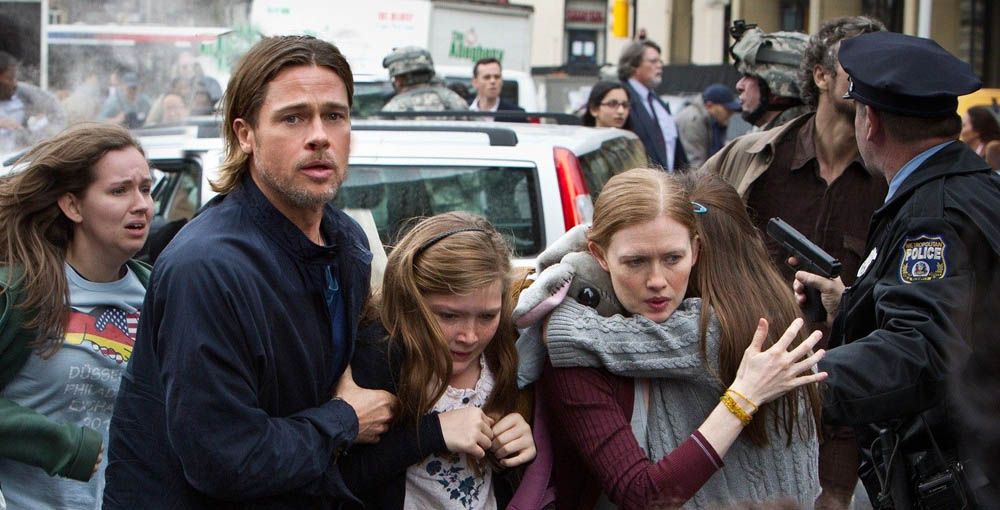A film whose troubled production seems destined to be remembered more vividly than the film itself, World War Z is the ultimate extension of B-grade (OK, I’ll play along, Z-grade) filmmaking writ large on a blockbuster scale.
Marc Forster, having apparently learned nothing as an action director following the debacle of Quantum of Solace, clumsily shepherds this adaptation of Max Brooks’ acclaimed novel to the screen, finding a through-line in the watery blue eyes of Brad Pitt even as he photographs some of the most disastrously incomprehensible set pieces ever conceived as summer spectacle. With too much wattage in its ubiquitous star to truly create any meaningful sense of jeopardy, World War Z is big-budget schlock too content to rely on cheap theatrics to tap into anything more substantive, even if its reportedly extensive re-shoots resulted in a third act that is considerably more engaging than the previous two.
Pitt plays Gerry Lane, a former United Nations serviceman called back into duty after the world descends -- more or less literally overnight -- into the throes of a zombie outbreak. Although he initially refuses to leave his wife Karen (Mireille Enos of The Killing) and two daughters Constance and Rachel, the military soon makes him an offer he can’t refuse: Help find a cure, or his family will be returned to the general populace and denied protection. But after discovering that even the survivors at the supposed origin point of the outbreak are no better informed than his superiors, Gerry soon sets out on a worldwide hunt for enough information to earn him the right to reunite with his family, whether or not it actually supplies the planet with a cure.
As a huge fan of zombie movies, it doesn’t matter to me whether they move fast or slow. But filmmakers have to make a choice between suspense, meaning they’re running and chasing, or dread, where they’re slowly and inevitably encroaching upon humanity – and this film refuses to come to a decision. The speed with which the creatures run, attack, mobilize, and spread their disease is itself terrifying; swarms demolish everything in their path, and provide an inescapable force that possesses just enough sentience to be able to chase its prey anywhere it attempts to hide. But the creatures are not smart, and they’re noisy, making their presence a constant source of uneasiness, but seldom one of surprise – except when the film is in desperate need of a completely implausible and arbitrary scare to throw off the audience.
The best example of this is at the beginning of the film, when a group of characters surveys a location only for a zombie to appear from nowhere, loudly and directly in their faces; it’s an effective scare, but no more meaningful or lasting than the surprise that comes from hearing a loud, unexpected noise. But the bigger problem is that these moments are essentially violations of the rules and of the behavior the film establishes for these monsters, which come to be defined by two things: their irresistible attraction to any sound, and their constant inclination to make one.
The impact of the film’s re-shoots is largely indiscernible, but the finale is conspicuously slower and quieter than the preceding sequences – which may play to some as underwhelming in the context of an escalating worldwide epidemic, but to this viewer, it was a welcome relief from Forster’s fully atrocious staging of action set pieces. Fairly, the first scenes are meant to be confusing, as the characters are themselves unsure of what’s happening, but every action sequence unfolds in a complete jumble of images that fails to communicate any sort of spatial or geographic clarity. During a scene in Israel where the characters flee through a grated tunnel above which zombies try to grab at them, it’s impossible to see how protected they are, what compromises that protection, and where they – or their pursuers – will or should end up.
Characters shoot, fight and flee, but it’s almost never clear where they are in relation to one another, the zombies or anything else, which becomes less suspenseful than maddening because you neither know if they’re safe nor in imminent danger. And in those moments, often you have the opposite feeling of the one that appears to be intended. That said, there’s a terrific a set piece where a zombie outbreak occurs on a plane, and even under the improbable circumstances that one section of the plane couldn’t hear another, the explosion of violence in a specific sort of contained space – rather than one defined by the limitations of the director’s camera – offers some genuine tension and thrills.
Having aged out of his matinee idol days, Pitt has comfortably transitioned into being a mature leading man, and yields to the age of his character, playing Gerry as definitively retired (as opposed to the “secretly hoping for a firefight” sort), and fully comfortable living in domestic bliss with his wife and daughters. He seems to have adopted some of the humility of contemporaries like Matt Damon and George Clooney, which of course communicates a greater and more impressive strength – namely, in having enough actorly self-confidence to not have to prove his virility over and over again. At the same time, the problem with being a movie star even in a movie like this is that he’s essentially untouchable, which means that all of his long shots pay off, his jeopardy is temporary and his triumphs inevitable.
As indicated above, the final third of the film slows down considerably, focusing on a World Health Organization facility where Gerry hopes he can concoct a cure. The sequence reminds audiences that these films really need to be about people, because without characters to invest in, there’s virtually no reason to watch them – more than once, anyway. In presenting the film’s global stakes in individual terms, the film finally achieves, if briefly, the relatability that most of the rest of the film lacks, thanks to its constant parade of new, marginally recognizable faces every few minutes. Although it unfolds in a more high-tech way, the end recalls scenes in Dawn of the Dead where the mall denizens would negotiate their way through lumbering armies of the undead to collect supplies: There’s an anticipation, and every once in a while, a genuine excitement at the notion of venturing so close to death in order to survive.
But for the most part, Forster’s World War Z feels like an overinflated B-movie, a story executed better many times over by filmmakers whose ambition was inversely proportionate to this one’s finances. Are there breathtaking shots of zombie swarms? Sure. Are there close calls that catapult audiences to the edge of their seats? Absolutely. But are there deeper and more meaningful ideas beneath its surface? Not really. Or even characters we can maintain a strong and lasting emotional connection with? Barely.
Despite its best intentions, the would-be blockbuster is basically exactly what it seems like: the showcase for an exorbitant budget rather the concepts that it was meant to bring to life. I suppose there’s something powerful about using a travelogue to chronicle a zombie outbreak, but especially when you can accomplish all of the same goals in a shopping mall, or even in one boarded up house – with memorable characters and clear thematic underpinnings, no less – World War Z feels like an excessively over-designed journey that doesn’t take its audience nearly far enough.
World War Z opens Friday nationwide.


